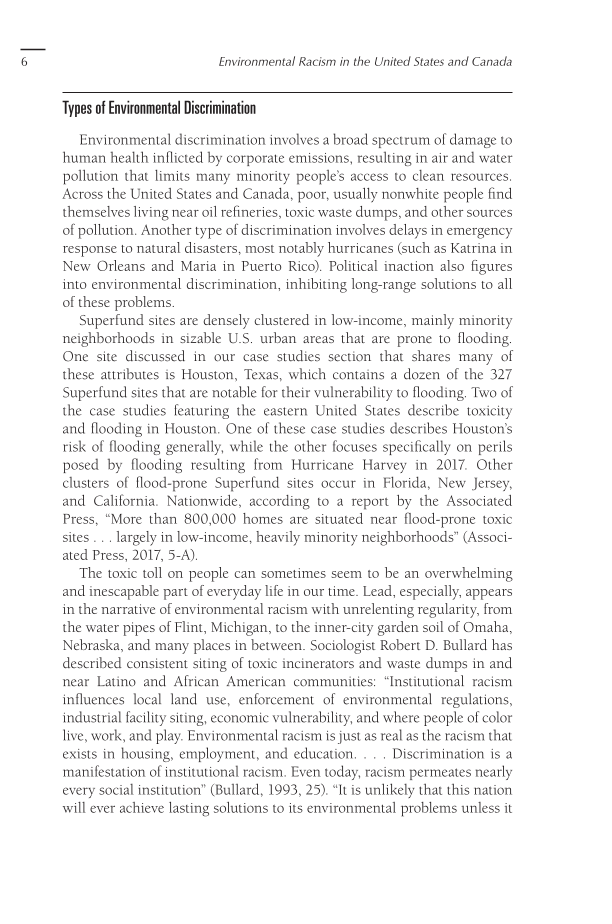6 Environmental Racism in the United States and Canada Types of Environmental Discrimination Environmental discrimination involves a broad spectrum of damage to human health inflicted by corporate emissions, resulting in air and water pollution that limits many minority people’s access to clean resources. Across the United States and Canada, poor, usually nonwhite people find themselves living near oil refineries, toxic waste dumps, and other sources of pollution. Another type of discrimination involves delays in emergency response to natural disasters, most notably hurricanes (such as Katrina in New Orleans and Maria in Puerto Rico). Political inaction also figures into environmental discrimination, inhibiting long-range solutions to all of these problems. Superfund sites are densely clustered in low-income, mainly minority neighborhoods in sizable U.S. urban areas that are prone to flooding. One site discussed in our case studies section that shares many of these attributes is Houston, Texas, which contains a dozen of the 327 Superfund sites that are notable for their vulnerability to flooding. Two of the case studies featuring the eastern United States describe toxicity and flooding in Houston. One of these case studies describes Houston’s risk of flooding generally, while the other focuses specifically on perils posed by flooding resulting from Hurricane Harvey in 2017. Other clusters of flood-prone Superfund sites occur in Florida, New Jersey, and California. Nationwide, according to a report by the Associated Press, “More than 800,000 homes are situated near flood-prone toxic sites . . . largely in low-income, heavily minority neighborhoods” (Associ- ated Press, 2017, 5-A). The toxic toll on people can sometimes seem to be an overwhelming and inescapable part of everyday life in our time. Lead, especially, appears in the narrative of environmental racism with unrelenting regularity, from the water pipes of Flint, Michigan, to the inner-city garden soil of Omaha, Nebraska, and many places in between. Sociologist Robert D. Bullard has described consistent siting of toxic incinerators and waste dumps in and near Latino and African American communities: “Institutional racism influences local land use, enforcement of environmental regulations, industrial facility siting, economic vulnerability, and where people of color live, work, and play. Environmental racism is just as real as the racism that exists in housing, employment, and education. . . . Discrimination is a manifestation of institutional racism. Even today, racism permeates nearly every social institution” (Bullard, 1993, 25). “It is unlikely that this nation will ever achieve lasting solutions to its environmental problems unless it
Document Details My Account Print multiple pages
Print
You have printed 0 times in the last 24 hours.
Your print count will reset on at .
You may print 0 more time(s) before then.
You may print a maximum of 0 pages at a time.






























































































































































































































































































































































































